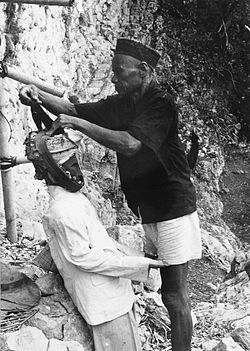Dew dew
Tau Tau are carved wooden figures that are common among the Toraja people in the Tanah Toraja highlands on the island of Sulawesi , Indonesia .
The word tau is a Toraja word for human and Tau Tau meaning human or statue . These figures are carved by wood carvers in the image of a deceased person. Whereas in the past dew was very simply carved and only showed the sex of the deceased, the wooden figures today show realistic facial features of the deceased and are given clothing. The relatives of the deceased give the woodcarver a picture of the deceased who then makes the wooden figure. They are placed in front of the graves of the deceased.
The first tau tau probably originated in the 19th century. Only members of the Toraja aristocratic class have Tau-Taus made, they reflect their status and wealth. The Tau Tau represents the deceased, it watches over the graves and protects the living. Since the Torajas believe that the dead can take their belongings with them to the afterlife, the Tau Taus are usually equipped with small possessions. In the early 1900s, with the arrival of the Dutch Christian missionaries in Toraja, the production of Tau Tau was somewhat subdued. At the synod of the Toraja Church in Palopo in 1985, it was discussed whether Protestant Torajas were allowed to receive tau tau at their funerals.
The profession of rope and rope manufacture may only be exercised by certain people who will pass this right on to their children. Whereas in the past the rope and rope manufacturers were dependent on a nobleman and were usually rewarded with a buffalo for their services, today the manufacturers are free and often demand several times the number of buffalo. The types of wood used for tau tau and what they are clad in also reflect the status and wealth of the deceased. The Tau Taus of the wealthy are usually made from the wood of the jackfruit tree. It is permanent and these statues can be found at the entrance to the burial chambers. Their position in relation to the other Tau Taus in the rock face corresponds to the status of the deceased. The less affluent elites have their ropes made of bamboo, and at the end of the funeral their clothes are stripped so that only the bamboo figure remains on the place of the ritual. There are also regional differences in the type of rope used.
In the 1980s, many Tau-Tau figurines were stolen and sold in antique markets and museums. A stolen rope has been shown in an exhibition on several occasions, for example at the Brooklyn Museum in 1981 and the Arnold Herstand Gallery in New York in 1984. They were even found at the Smithsonian Institute in 1991 . In response to this pillaging of their ancestors, the Torajas hide their rope in various secret places. They also put metal fences around their burial caves to protect the Tau Taus.
Web links
Individual evidence
- ↑ a b Patrick Blanche: The tau tau of the Toraja . In: Raw Vision . Retrieved January 30, 2011.
- ^ A b Adams, Kathleen M. 2006 Art as Politics: Re-crafting Identities, Tourism and Power in Tana Toraja, Indonesia. Honolulu: University of Hawaii Press. http://www.uhpress.hawaii.edu/p-9780824830724.aspx
- ↑ Jesmond Sammut: Tau tau gallery at Toraja burial site . The Australian Museum. October 23, 2009. Retrieved January 30, 2011.
- ↑ Toby Alice Volkman: Visions and Revisions: Toraja Culture and the Tourist Gaze . In: American Ethnologist . 17, No. 1, February 1990, pp. 91-110. JSTOR 645254 . doi : 10.1525 / ae.1990.17.1.02a00060 .
- ↑ Kathleen M. Adams: Theologians. Tourists. and Thieves: The Torajan Effigy of the Dead in Modernizing Indonesia . In: Kyoto Journal . 22, 1993, pp. 38-46.


